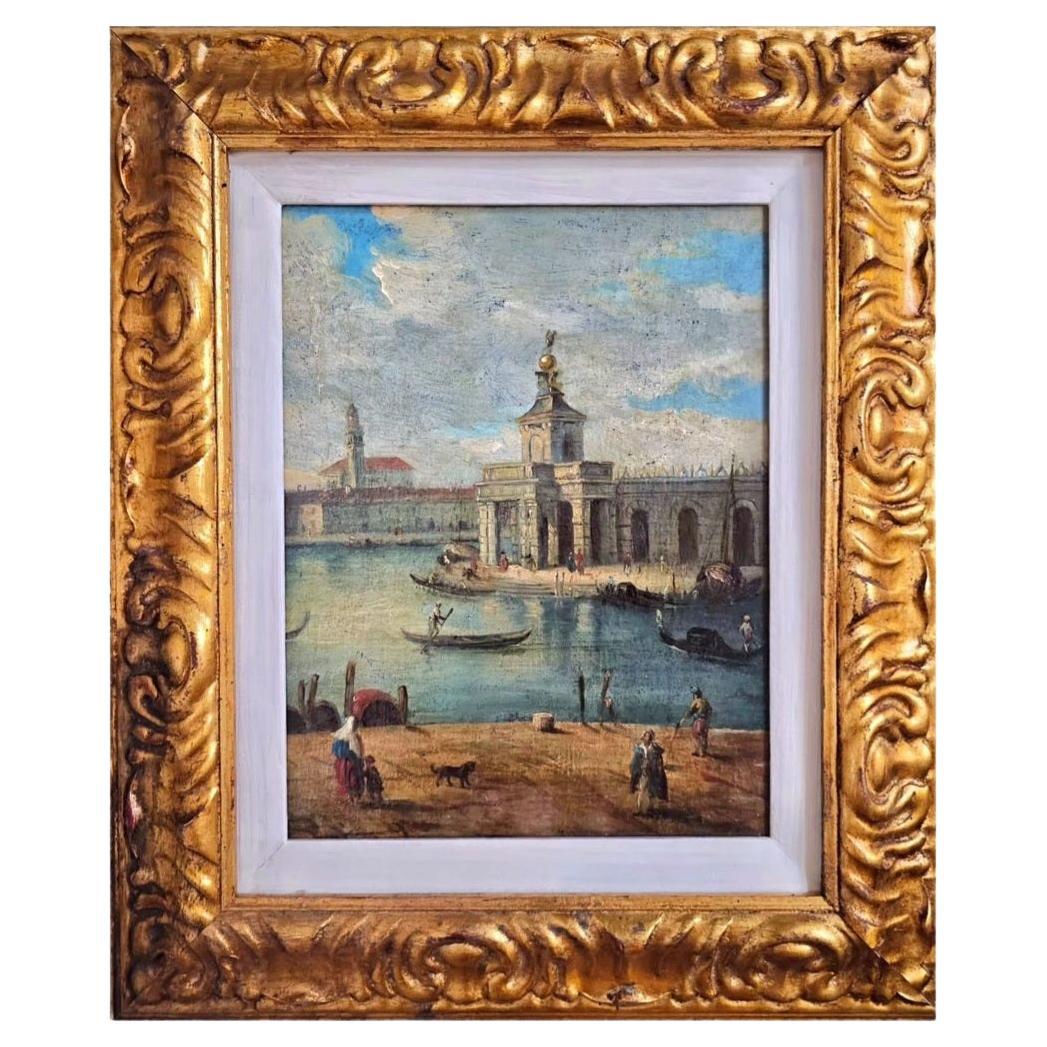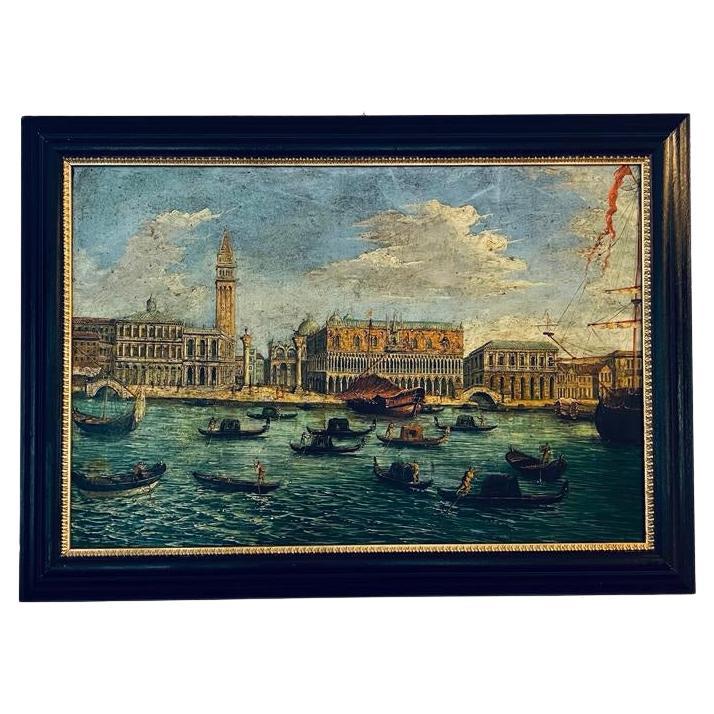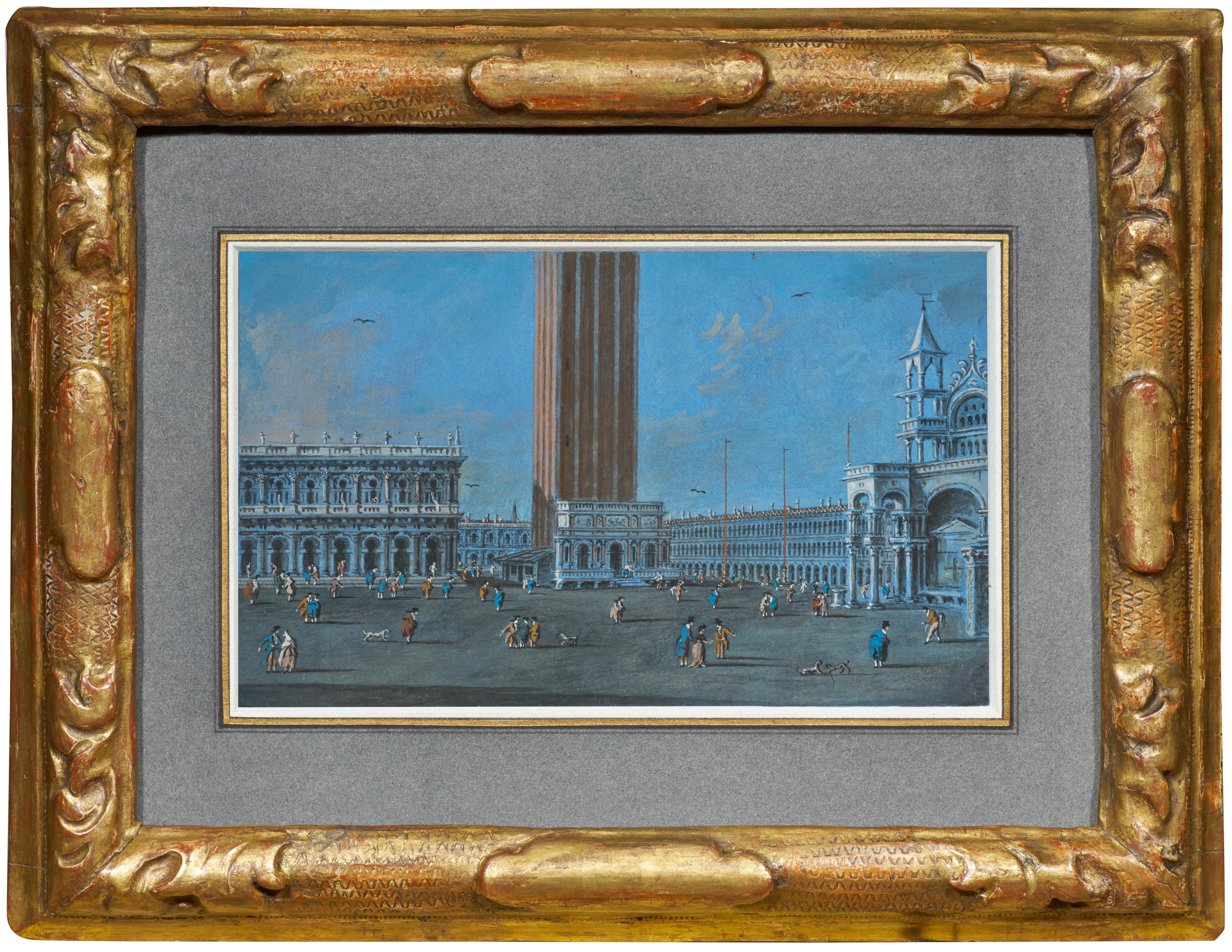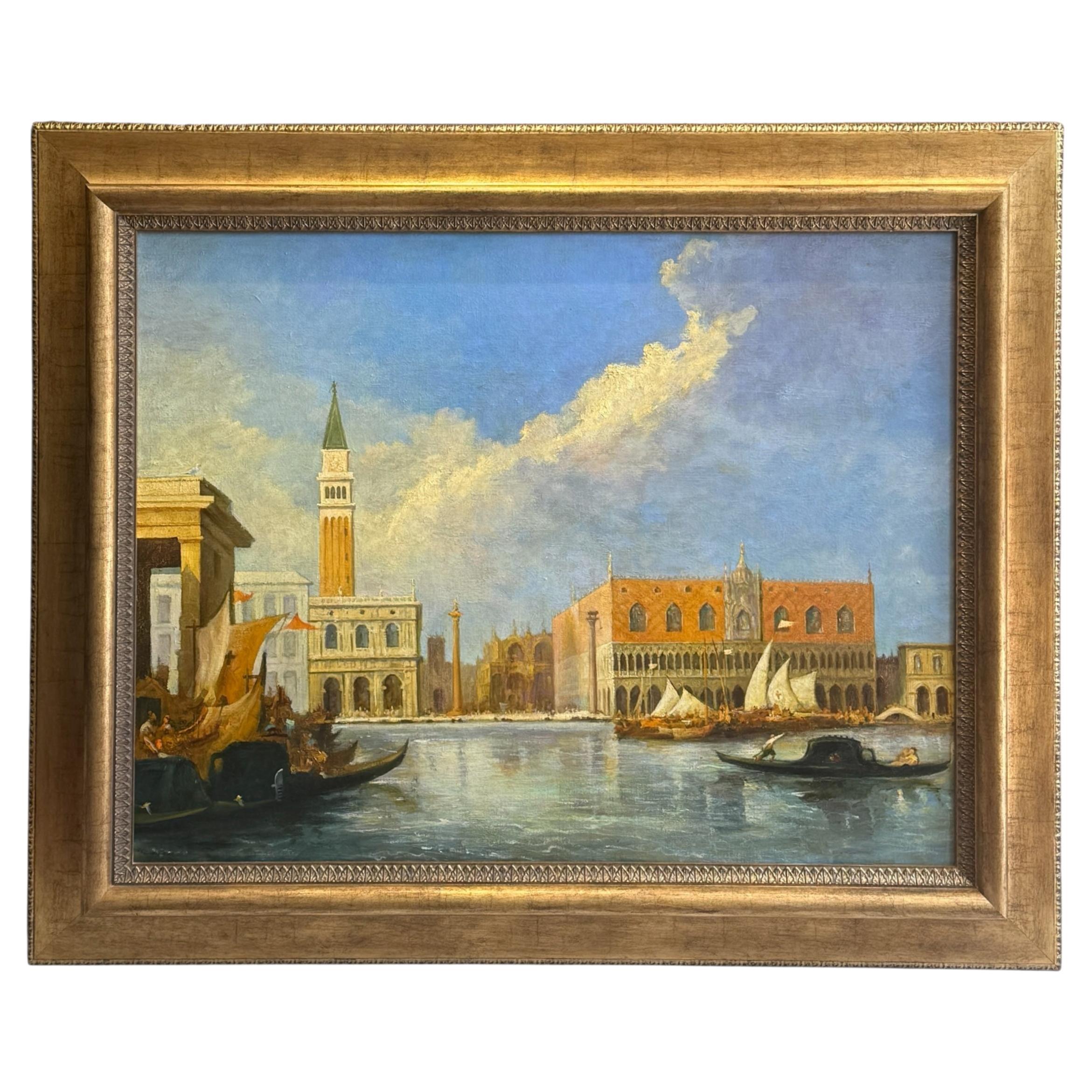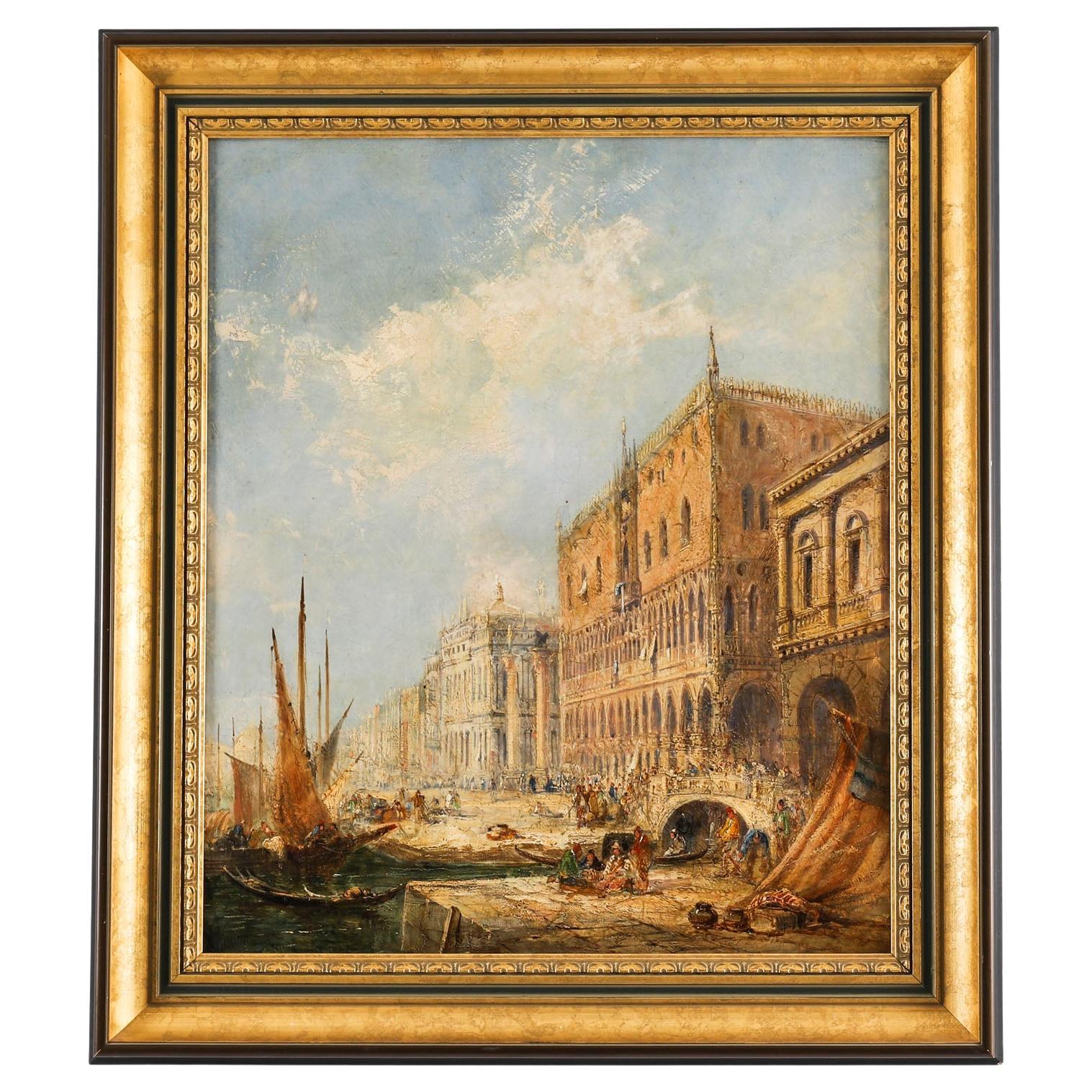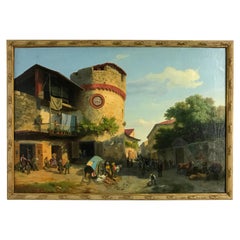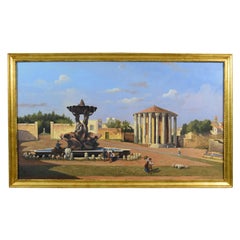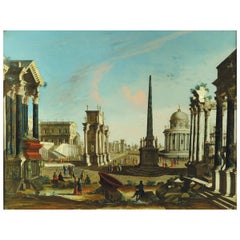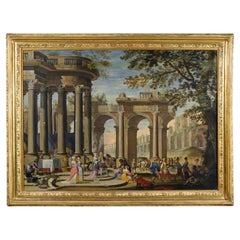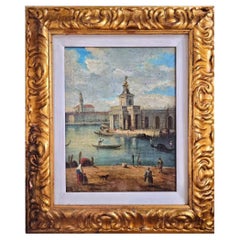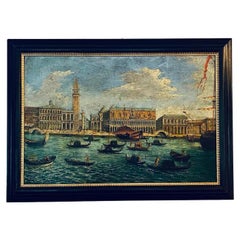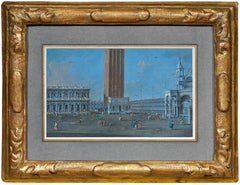Items Similar to 19th Century, View of Piazza San Marco in Venice, Follower of Francesco Guardi
Want more images or videos?
Request additional images or videos from the seller
1 of 21
19th Century, View of Piazza San Marco in Venice, Follower of Francesco Guardi
$19,718.87
£14,597.92
€16,500
CA$27,285.99
A$30,077.59
CHF 15,738.03
MX$369,042.67
NOK 198,110.60
SEK 185,264.74
DKK 125,630.92
About the Item
19th Century, View of Piazza San Marco in Venice, Follower of Francesco Guardi
Dimensions: frame, cm W 121.5 x H 105 x D 5.5. Canvas cm W 100 x H 81
The work, created by a Venetian painter active in the first half of the 19th century, a follower of Francesco Guardi, depicts Piazza San Marco in Venice, with the Clock Tower in the background. The view is inspired by the artistic production of the famous painter Francesco Guardi (Venice, 1712 – 1793) based on a perspective frequently reproduced by the master. Guardi depicted it in several of his paintings, and a few versions are known with this particular viewpoint. The canvas in question reprises a version Guardi created and signed between 1760 and 1770, now in a private collection.
The focal point of the composition is the Renaissance Clock Tower, an imposing structure of the square, depicted with intricate details. The Tower is one of the most iconic architectural landmarks of Venice: it looms like a triumphal arch over the entrance to the city’s commercial heart, the ancient Merceria. With its large astronomical clock, a masterpiece of both technique and engineering, it is part of the very image of Venice and has marked the life, history, and continuous passage of time.
It was built between 1496 and 1499, and later expanded in 1506 and 1757 to reach its current form. The tower was constructed during the rule of Agostino Barbarigo, who was Doge of Venice from 1486 to 1501. His coat of arms still decorates the exterior of the bell, and a statue of the Doge kneeling was once placed to the right of the winged lion. Destroyed in 1797, it is still clearly visible in the painting.
The square is bustling with figures that, though small, are rendered in a loose style that emphasizes their movement. Stalls with white canopies suggest a lively market. The buildings surrounding the square are described with varying levels of detail, showing the typical Venetian architecture of the time. Tall flagpoles are visible, contributing to the atmosphere of the scene. The light blue sky is lively with a few clouds.
In the late 17th century, European tourism began, and it developed throughout the 18th century; nobles and wealthy bourgeoisie visited Italy to acquire art and antique objects or to deepen their knowledge from books. The essential destinations of the Grand Tour were Venice, for the uniqueness of its environments, Florence, for Renaissance art, Rome, for art, churches, and classical memories, Naples, the largest Italian city at that time, and Sicily, for the Greek temples and Mediterranean climate. This gave rise to a new art market: people wanted a memento of what they had visited, a view, a monument represented in painting. In Venice, an important school of vedutisti emerged, with Canaletto, Bernardo Bellotto, and Francesco Guardi standing out.
Francesco Guardi, after training in his brother Gianantonio's workshop, entered the workshop of Michele Marieschi, a painter of views and capricci, architect, and quadraturist, in 1735, staying there until Marieschi’s death in 1743. Equally influenced by the artistic production of Alessandro Magnasco and occasionally Canaletto, Guardi distanced himself from other masters towards a more personal expression, proposing a subjective and evocative interpretation of reality. He created images of cities that were evanescent and unreal, sometimes reaching an almost pre-romantic sensitivity, using color and light to build form, with ample space for melancholic and vibrant penumbra. A prolific painter, he died in 1783 in his Venetian home.
The painting, highly decorative, well represents the fortune that Guardi’s works had, remaining in demand even years after his death, with various commissions requesting his followers to reproduce his subjects. Alongside its artistic value, there is historical significance: it is a view that reflects customs, uses, and architecture that have changed over the centuries, but are well documented in this canvas.
The work is presented in an antique frame with non-contemporary gilding.
- Similar to:Francesco Guardi (Painter)
- Dimensions:Height: 41.34 in (105 cm)Width: 48.04 in (122 cm)Depth: 2.37 in (6 cm)
- Style:Neoclassical (In the Style Of)
- Materials and Techniques:
- Place of Origin:
- Period:
- Date of Manufacture:19th Century
- Condition:Wear consistent with age and use. The work is presented in an antique frame with non-contemporary gilding.
- Seller Location:IT
- Reference Number:1stDibs: LU4405243691122
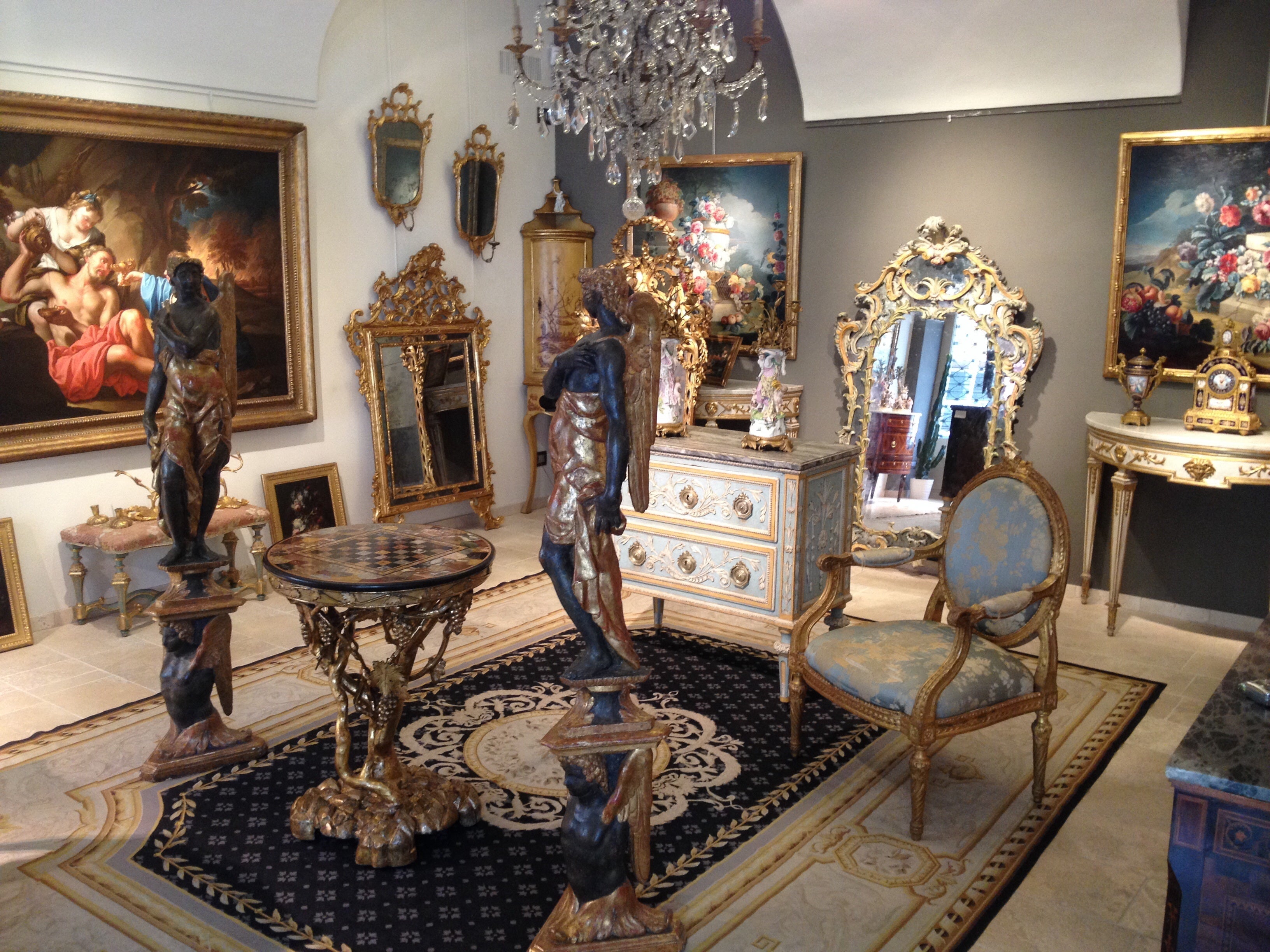
About the Seller
5.0
Platinum Seller
Premium sellers with a 4.7+ rating and 24-hour response times
Established in 1980
1stDibs seller since 2019
56 sales on 1stDibs
Typical response time: <1 hour
- ShippingRetrieving quote...Shipping from: Italy
- Return Policy
Authenticity Guarantee
In the unlikely event there’s an issue with an item’s authenticity, contact us within 1 year for a full refund. DetailsMoney-Back Guarantee
If your item is not as described, is damaged in transit, or does not arrive, contact us within 7 days for a full refund. Details24-Hour Cancellation
You have a 24-hour grace period in which to reconsider your purchase, with no questions asked.Vetted Professional Sellers
Our world-class sellers must adhere to strict standards for service and quality, maintaining the integrity of our listings.Price-Match Guarantee
If you find that a seller listed the same item for a lower price elsewhere, we’ll match it.Trusted Global Delivery
Our best-in-class carrier network provides specialized shipping options worldwide, including custom delivery.More From This Seller
View All19th Century, Italian Oil on Canvas, Market at Giaveno Tower by Carlo Piacenza
By Carlo Piacenza
Located in IT
Carlo Piacenza (Italy -Turin, December 3, 1814 - Castiglione Torinese, 1887)
Market at the Giaveno Tower
Italy, Piedmont, 1850-1860
Oil on canvas
The oil on canvas pain...
Category
Antique Mid-19th Century Italian Romantic Paintings
Materials
Canvas
19th Century, Oil on Canvas, Italian View of the Forum Boario of Rome
Located in IT
19th century, oil on canvas, Italian View of the forum Boario of Rome
The fine painting represents the Piazza della Bocca della Verità, located in the Ripa district, in the area of the Foro Boario, the oldest market in Rome (Italy). On the right is described the Roman Temple of about 100 B.C. wrongly called of Vesta, circular Corinthian monopter with cell of white marble ashlar and twenty fluted columns. From the 12th century it was reused as a church dedicated to Santo Stefano delle carrozze, then, in the 18th century, in Santa Maria del Sole. On the right you can see the fountain called "dei tritoni" which was built in 1717 on a design by architect Carlo Bizzaccheri. The fountain has a star-shaped bathtub, in honour of the commissioner, the Pope Clement XI...
Category
Antique Early 19th Century Italian Neoclassical Paintings
Materials
Canvas
18th Century, Roman Architectural Capriccio Attributed to Francesco Chiarottini
Located in IT
Francesco Chiarottini (1748-1796)
Roman Architectural Capriccio
Oil on glass, cm 52 x 67 without frame, 63.5 x 79cm with frame
The valuable painting, attributed to the Italian p...
Category
Antique Mid-18th Century Italian Neoclassical Paintings
Materials
Glass
18th Century, Painting Architectural Capriccio, att. to Isaac De Moucheron
Located in IT
18th Century, Painting with Architectural Capriccio with figures, attributed to Isaac De Moucheron
Measures: canvas cm H 108 x L 152; with frame cm H 132 x L 176 x 8
The painting i...
Category
Antique 18th Century Dutch Baroque Paintings
Materials
Canvas
Alberto Carlieri, Painting with Architectural Capriccio
By Alberto Carlieri
Located in IT
Alberto Carlieri (Rome 1672-1720)
"Architectural capriccio with the preaching of Saint Paul in the Areopagus of Athens"
Oil on canvas, measures with...
Category
Antique Late 17th Century European Baroque Paintings
Materials
Canvas
Italian Painting Architectural Capriccio with Caio Cestio Pyramid after Panini
Located in IT
19th century, Italian Painting Architectural Capriccio with the Pyramid of Caio Cestio, Roman painter, after Giovanni Paolo Panini, unsigned.
Dimensions: cm H 48 x W 63.5, frame H 6...
Category
Antique 19th Century Italian Rococo Paintings
Materials
Wood
You May Also Like
Venice Dogana, Oil on Canvas, Venetian School, in style of Francesco Guardi
By Francesco Guardi
Located in Beograd, RS
In this listing you will find a painting done in style of Francesco Guardi Guardi. The painting depicts Dogana da Mar, located in Punta della Dogana - the triangular area of Venice, ...
Category
Antique 1810s Italian Paintings
Materials
Canvas, Wood
“Venice, Piazza San Marco” circle of Gaspare Vanvitelli Oil on Canvas ca 1730
Located in Doha, QA
This is an absolutely stunning 18th century topographical painting, genre of which known as “veduta”. The crucial role in the development of that genre played Caspar van Wittel or Gaspar van Wittel -known in Italian as Gaspare Vanvitelli...
Category
Antique 18th Century Italian Baroque Paintings
Materials
Canvas
View of Piazza San Marco, a tempera signed by Giacomo Guardi (1764 - 1835)
Located in PARIS, FR
Signed and localized on the verso :
"Vedute di parte dalla Piazza dif.a alla Loggetta e cam
panil parte della Zecca ed in lontan Proc.e vechie e parte della chiesa
punto preso vic...
Category
Early 19th Century Old Masters Landscape Drawings and Watercolors
Materials
Tempera
19th Century Oil Painting of St Mark's Square in Venice from the Ducal Palaca
By Edward Pritchett
Located in Gerrards Cross, GB
‘Piazza San Marco from the Palazzo’ by Edward Pritchett RWS (1807-1876).
The painting – which depicts St. Mark’s Square and the Campanile seen from the Porto della Carta entrance to...
Category
Mid-19th Century English School Landscape Paintings
Materials
Oil
Venetian Grand Canal Scene – Framed Oil Painting on canvas, 19th Century
Located in NICE, FR
Majestic large-format oil painting, capturing the full splendor of Venice’s Grand Canal beneath a vast, luminous sky, with a panoramic view of the Doge’s Palace and the Campanile of ...
Category
Antique 1870s Italian Napoleon III Paintings
Materials
Canvas
Antique Oil Painting The Doges Palace Venice Jane Vivian 19th Century
By Jane Vivian
Located in London, GB
This beautiful oil on canvas painting by Jane Vivian (Active 1869-1890) beautifully captures a stunning Venetian Scene, The Doges Palace, Circa 1880 in date.
The Doges Palace is a p...
Category
Antique Late 19th Century English Paintings
Materials
Canvas, Giltwood
More Ways To Browse
San Marco Italy
Antique Flagpoles
Astronomical Clock
Royal Carriage
Sculptural Headboard
Shell Fountains
Side By Side Dresser
Silver Crest Bronze
Silver Snuff Box German
Simmons Vintage Furniture
Single Brass Bed
Sitting Greyhounds
Slip Cover Bed
Spanish Coffer
Spice Set
Staffordshire Dog Figurines
Stone Effigy
Stone Foo Dogs
